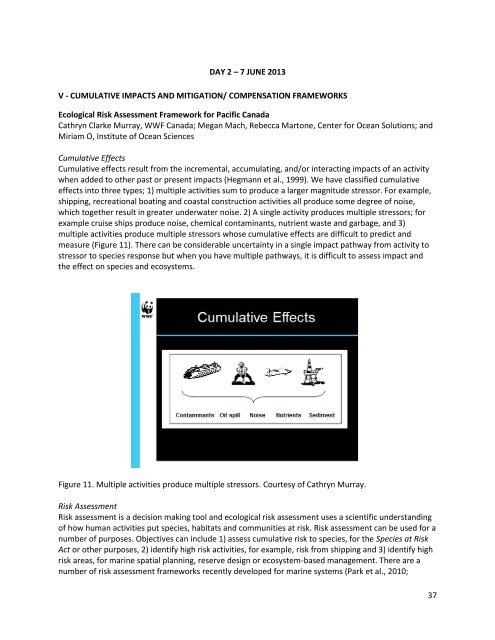mcbem-2014-01-submission-wwf-en
mcbem-2014-01-submission-wwf-en
mcbem-2014-01-submission-wwf-en
You also want an ePaper? Increase the reach of your titles
YUMPU automatically turns print PDFs into web optimized ePapers that Google loves.
DAY 2 – 7 JUNE 2<strong>01</strong>3<br />
V - CUMULATIVE IMPACTS AND MITIGATION/ COMPENSATION FRAMEWORKS<br />
Ecological Risk Assessm<strong>en</strong>t Framework for Pacific Canada<br />
Cathryn Clarke Murray, WWF Canada; Megan Mach, Rebecca Martone, C<strong>en</strong>ter for Ocean Solutions; and<br />
Miriam O, Institute of Ocean Sci<strong>en</strong>ces<br />
Cumulative Effects<br />
Cumulative effects result from the increm<strong>en</strong>tal, accumulating, and/or interacting impacts of an activity<br />
wh<strong>en</strong> added to other past or pres<strong>en</strong>t impacts (Hegmann et al., 1999). We have classified cumulative<br />
effects into three types; 1) multiple activities sum to produce a larger magnitude stressor. For example,<br />
shipping, recreational boating and coastal construction activities all produce some degree of noise,<br />
which together result in greater underwater noise. 2) A single activity produces multiple stressors; for<br />
example cruise ships produce noise, chemical contaminants, nutri<strong>en</strong>t waste and garbage, and 3)<br />
multiple activities produce multiple stressors whose cumulative effects are difficult to predict and<br />
measure (Figure 11). There can be considerable uncertainty in a single impact pathway from activity to<br />
stressor to species response but wh<strong>en</strong> you have multiple pathways, it is difficult to assess impact and<br />
the effect on species and ecosystems.<br />
Figure 11. Multiple activities produce multiple stressors. Courtesy of Cathryn Murray.<br />
Risk Assessm<strong>en</strong>t<br />
Risk assessm<strong>en</strong>t is a decision making tool and ecological risk assessm<strong>en</strong>t uses a sci<strong>en</strong>tific understanding<br />
of how human activities put species, habitats and communities at risk. Risk assessm<strong>en</strong>t can be used for a<br />
number of purposes. Objectives can include 1) assess cumulative risk to species, for the Species at Risk<br />
Act or other purposes, 2) id<strong>en</strong>tify high risk activities, for example, risk from shipping and 3) id<strong>en</strong>tify high<br />
risk areas, for marine spatial planning, reserve design or ecosystem-based managem<strong>en</strong>t. There are a<br />
number of risk assessm<strong>en</strong>t frameworks rec<strong>en</strong>tly developed for marine systems (Park et al., 2<strong>01</strong>0;<br />
37


